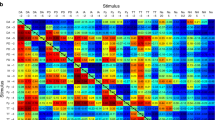Abstract
Animals facing conflicting sensory cues make a behavioral choice through the integration of sensory cues. This kind of sensory processing is important even for simple organisms. We studied the molecular and neuronal mechanisms of such behavioral choice by using nematode C. elegans as a model organism. Our genetic analyses revealed that the information about two conflicting sensory cues is processed in a pair of interneurons, in which two signaling pathways regulate the sensory integration independently.
Access this chapter
Tax calculation will be finalised at checkout
Purchases are for personal use only
Similar content being viewed by others
References
Ishihara, T. et al.: HEN-1, a secretory protein with an LDL receptor motif, regulates sensory integration and learning in Caenorhabditis elegans. Cell.109 (2002) 639–649
Kristan, W.B.: Neuronal decision-making circuits. Curr Biol.18(2008) R928–R932
White, J.G. et al.: The structure of the nervous system of the Nematode Caenorhabditis elegans. Philos Trans R Soc Lond B Biol Sci.314(1986) 1–340
Bargmann, C.I. et al.: Odorant-selective genes and neurons mediate olfaction in C. elegans. Cell. 74 (1993) 515–527
Sambongi, Y. et al.: Sensing of cadmium and copper ions by externally exposed ADL, ASE, and ASH neurons elicits avoidance response in Caenorhabditis elegans. Neuroreport.10(1999) 753–757
Englund, C. et al.: Jeb signals through the Alk receptor tyrosine kinase to drive visceral muscle fusion..Nature.425(2003) 512–516
Shinkai, Y. et al.: Behavioral choice between conflicting alternatives is regulated by a receptor guanylyl cyclase, GCY-28, and a receptor tyrosine kinase, SCD-2, in AIA interneurons of Caenorhabditis elegans..J Neurosci.31(2011) 3007–3015
Hilliard, M.A. et al.: In vivo imaging of C. elegans ASH neurons: cellular response and adaptation to chemical repellents..EMBO J.24(2005) 63–72
Harbinder, S. et al.: Genetically targeted cell disruption in Caenorhabditis elegans..Proc Natl Acad Sci U S A.94(1997) 13128–13133
Reiner D.J. et al.:Behavioral genetics of Caenorhabditis elegans unc-103-encoded erg-like K(+) channel. J Neurogenet 20(2006)41–66
Author information
Authors and Affiliations
Corresponding author
Editor information
Editors and Affiliations
Rights and permissions
Copyright information
© 2013 Springer Science+Business Media Dordrecht
About this paper
Cite this paper
Ishihara, T. (2013). Molecular and Neural Mechanisms for Behavioral Choice Between Two Conflicting Alternatives in C. elegans . In: Yamaguchi, Y. (eds) Advances in Cognitive Neurodynamics (III). Springer, Dordrecht. https://doi.org/10.1007/978-94-007-4792-0_63
Download citation
DOI: https://doi.org/10.1007/978-94-007-4792-0_63
Published:
Publisher Name: Springer, Dordrecht
Print ISBN: 978-94-007-4791-3
Online ISBN: 978-94-007-4792-0
eBook Packages: Biomedical and Life SciencesBiomedical and Life Sciences (R0)




